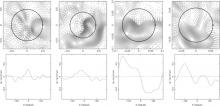
Abstract
The density of stars in galactic bulges is often observed to be flat or slowly rising inside the influence radius of the supermassive black hole (SMBH). Chandrasekhar's dynamical friction formula predicts little or no frictional force on a test body in such a core, regardless of its density, due to the absence of stars moving more slowly than the local circular velocity. We have tested this prediction using large-scale N-body experiments. The rate of orbital decay never drops precisely to zero, because stars moving faster than the test body also contribute to the frictional force. When the contribution from the fast-moving stars is included in the expression for the dynamical friction force, and the changes induced by the massive body on the stellar distribution are taken into account, Chandrasekhar's theory is found to reproduce the rate of orbital decay remarkably well. However, this rate is still substantially smaller than the rate predicted by Chandrasekhar's formula in its most widely-used forms, implying longer time scales for inspiral.Motivated by recent observations that suggest a parsec-scale core around the Galactic center SMBH, we investigate the evolution of a population of stellar-mass black holes (BHs) as they spiral in to the center of the Galaxy. After 10 Gyr, we find that the density of BHs can remain substantially less than the density in stars at all radii; we conclude that it would be unjustified to assume that the spatial distribution of BHs at the Galactic center is well described by steady-state models. One consequence is that rates of capture of BHs by the SMBH at the Galactic center (EMRIs) may be much lower than in standard models. When capture occurs, inspiraling BHs often reach the gravitational-radiation-dominated regime while on orbits that are still highly eccentric; even after the semi-major axis has decreased tovalues small enough for detection by space-based interferometers, eccentricities can be large enough that the efficient analysis of gravitational wave signals would require the use of eccentric templates.